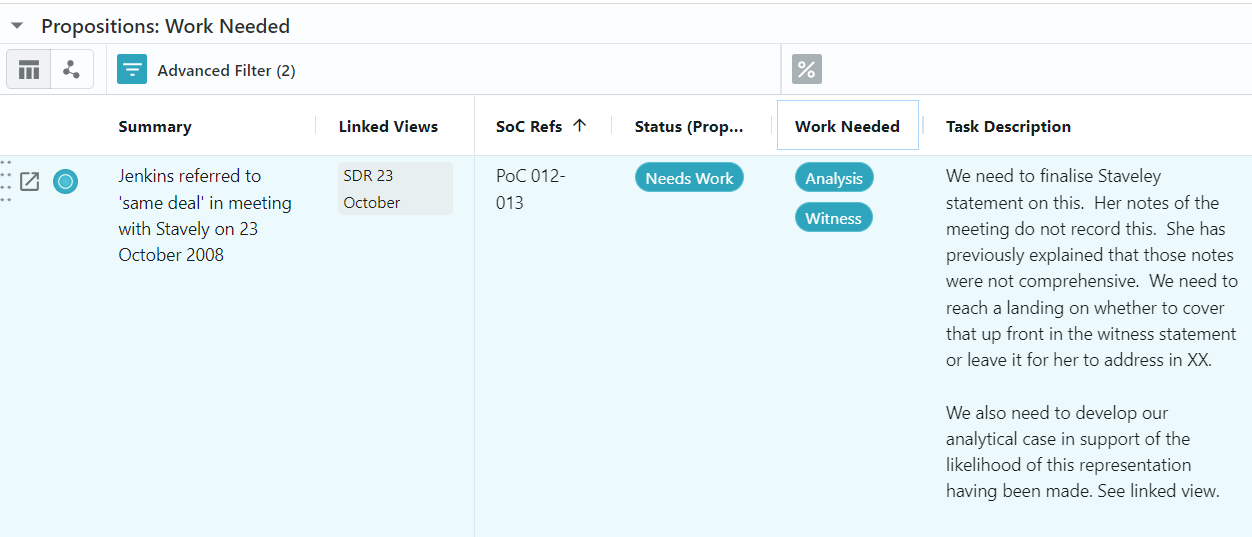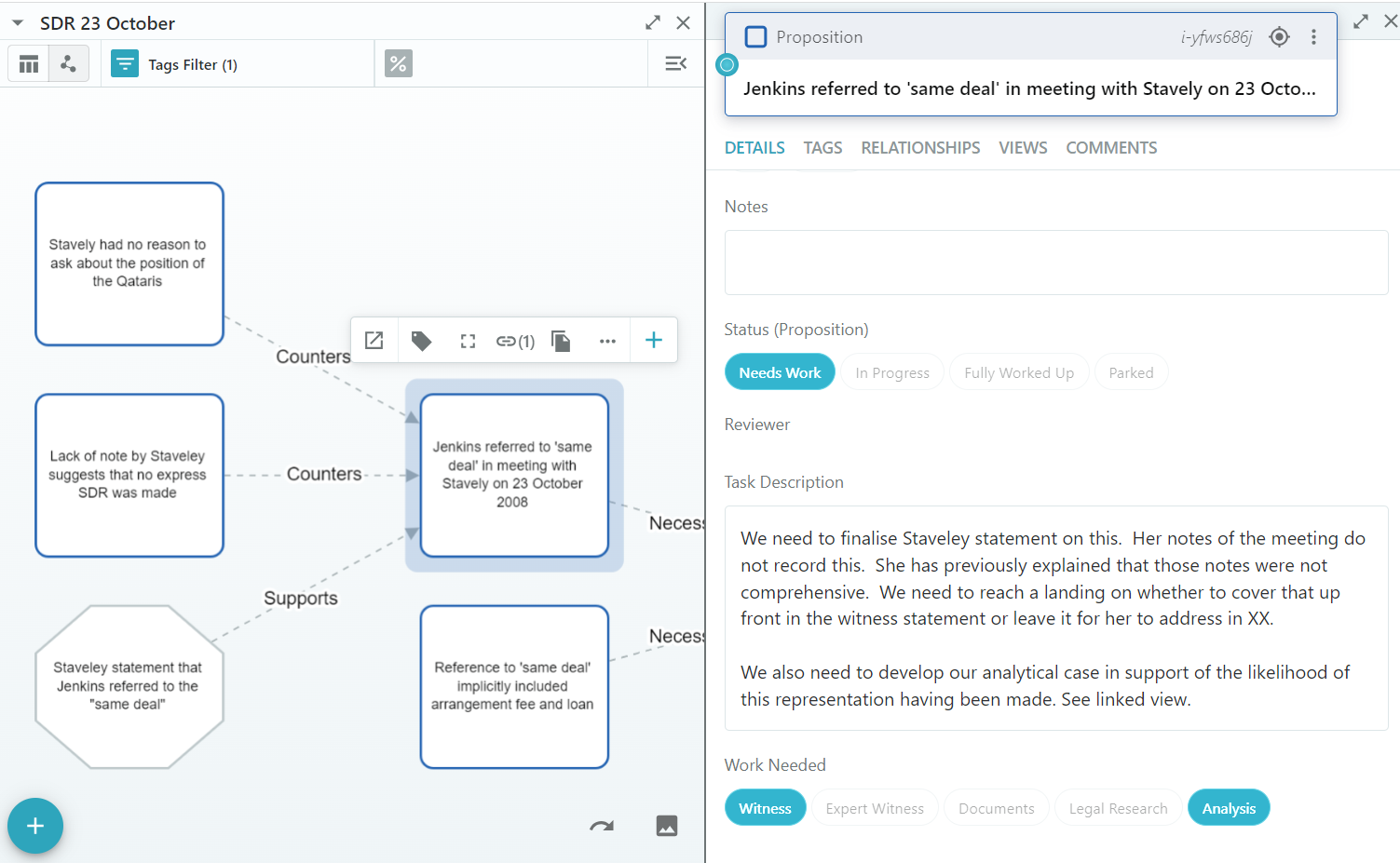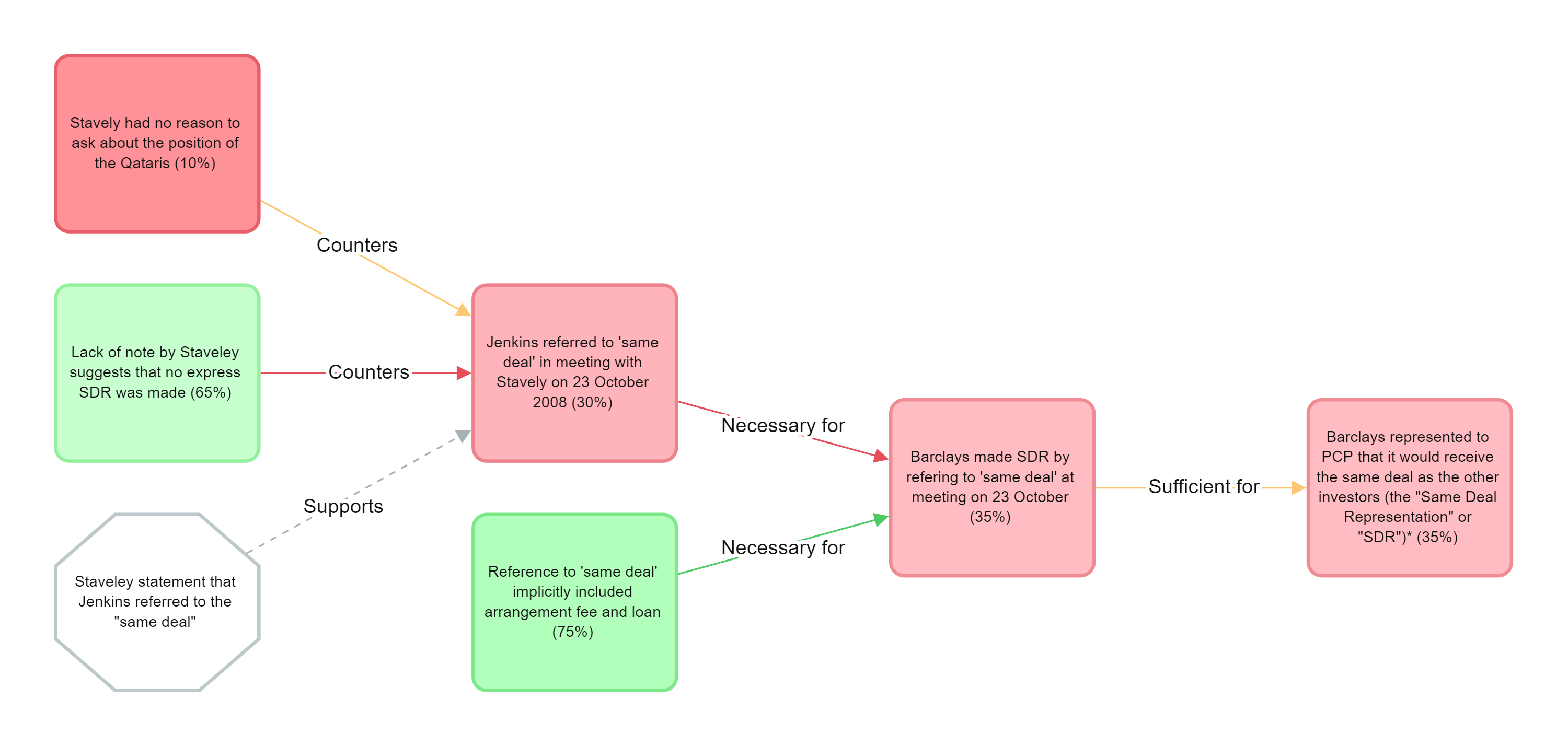You have 100+ pages of statements of case, 1,000+ documents to review and you now need to prepare witness statements and expert reports and generally get the case ready for trial. This is a critical phase, both in terms of winning the case and keeping the budget under control.
Associo is a flexible database and visualisation tool that can be configured to support many different ways of working. In this article, David Blayney KC describes how litigation teams can use Associo at the evidence preparation stage of cases to improve efficiency and reliability while retaining the best features of traditional techniques.
1. Maintain a database of relevant propositions
Propositions (i.e. assertions of fact or law) are the fundamental building blocks of every case. Cases are won by persuading the tribunal to accept or reject propositions that help or hinder your client's overall case theory.
Because they play such a central role in the case, propositions are worked on by multiple people and in multiple places as the case is prepared. This makes it hard to keep track of the progress of each proposition towards being fully "worked up", creates significant risks of inconsistency, and often results in duplication of work.
Using Associo, different members of the case team can simultaneously work on propositions in multiple different contexts, whilst easily keeping track of the status of each proposition and benefiting from each other's work.
This is made possible by storing each proposition as a record in Associo's database and thereby maintaining a "single source of truth" for each proposition, capturing all relevant information both (a) from an analytical perspective (i.e. as to the likelihood of that proposition being upheld) and (b) from a project management perspective (i.e. as to the work done and needing to be done to work up that proposition).
Associo's flexibility allows case teams to design their own workflows to meet the needs of the case and their individual preferences. But it is always useful to have a recommended approach to use as a starting point. We suggest that case teams start by working with the following tables of propositions, which provide a streamlined way of performing activities that will be very familiar to most disputes lawyers:
- {"nodeType":"list-item","data":{},"content":[{"nodeType":"paragraph","data":{},"content":[{"nodeType":"text","value":"a global ","marks":[],"data":{}},{"nodeType":"text","value":"Propositions: Work Needed ","marks":[{"type":"bold"}],"data":{}},{"nodeType":"text","value":"table, which tracks and progress on all the propositions needing to be worked up","marks":[],"data":{}}]}]}
- {"nodeType":"list-item","data":{},"content":[{"nodeType":"paragraph","data":{},"content":[{"nodeType":"text","value":"a global ","marks":[],"data":{}},{"nodeType":"text","value":"Factual Chronology ","marks":[{"type":"bold"}],"data":{}},{"nodeType":"text","value":"(comprising every proposition with a date specified and linked to relevant evidence as described in Section 3 below)","marks":[],"data":{}}]}]}
- {"nodeType":"list-item","data":{},"content":[{"nodeType":"paragraph","data":{},"content":[{"nodeType":"text","value":"a set of individual ","marks":[],"data":{}},{"nodeType":"text","value":"Topic Chronologies","marks":[{"type":"bold"}],"data":{}},{"nodeType":"text","value":", each comprising the dated propositions tagged for each topic or main issue in the case, and","marks":[],"data":{}}]}]}
- {"nodeType":"list-item","data":{},"content":[{"nodeType":"paragraph","data":{},"content":[{"nodeType":"text","value":"a ","marks":[],"data":{}},{"nodeType":"text","value":"Pleaded Propositions","marks":[{"type":"bold"}],"data":{}},{"nodeType":"text","value":" table ordered by paragraph number from the statements of case.","marks":[],"data":{}}]}]}
Below, we'll look at how this can be done.
The image below shows a row from a Propositions: Work Needed table in Associo. (This is from a demo that is reconstructed around the PCP v Barclays case, imagining how the Claimant's evidence preparation workflows could have been managed using Associo.)

The status of this proposition is set to "Needs Work", with the type of "Work Needed" shown as being "Analysis" and "Witness". In the "Task Description", there is a summary of what needs to be done. This is the perfect place to communicate instructions from senior team members and/or advice from counsel as to how each proposition should be worked up. This proposition can now be assigned to a more junior member of the team to work up, and the assignment can also be recorded in Associo.
As each proposition is worked on, its status can be updated, ultimately to "fully worked up". Using Associo to allocate and track work on propositions gives you a robust and efficient process for ensuring that all material propositions are properly worked up and ready for trial. It also makes the team's workflows more enjoyable and satisfying, not least because your brain gets a dopamine hit from ticking off tasks as done!
2. Map the logic of the main arguments
Now let's explore the benefits of adding visualisation to the process of working up propositions.
Often, many of the important points in your case can't be proved or disproved directly by evidence; instead, they are determined by a combination of evidence and logical argument. It is striking how often case teams overlook flaws or gaps in the logic of their arguments.
The risk of failing to see one of these flaws or gaps is greatly reduced by mapping arguments visually in a "graph" format as a series of propositions linked by logical relationships (such as "necessary for" or "supports").
The image below shows a partly worked-up example from PCP v Barclays.

The power of visually mapping out arguments needs to be experienced to be fully appreciated! A visual map provides a fast and robust way of developing and understanding the structure and flow of the arguments in the case. After just a couple of hours mapping the analysis in a complex construction dispute, one case team reported: "..the organisational rigor [Associo] encourages has already set us moving to fill holes in our understanding of the case that are now overwhelmingly obvious".
As described in Section 1 above, the status of the individual propositions within these arguments, and the evidence affecting them, can be managed and tracked. Adding a proposition in the argument to your pipeline of propositions to be worked up is as simple as double-clicking on a proposition in the graph. Doing so will bring up its attributes, and you can then select the "needs work" option in the status field.

Propositions flagged in this way as needing work automatically appear in the corresponding lists of propositions needing to be worked up.
Associo thus provides a simple procedure for tracking the progress of work on each item, and you can view that progress as a heatmap within the graph, enabling case teams to see at a glance where their efforts need to be concentrated.

Using Associo in this manner brings project management discipline directly into the structure of your arguments, and keeps the team focused on the activities that matter most to winning the case.
3. Maintain a table of relevant documents and link documents to propositions
Of course, case teams also need to keep track of what evidence exists to support or counter disputed propositions.
The approaches traditionally adopted for this, such as tagging or listing any document that may be necessary to support or disprove a proposition, have significant shortcomings. You tend to end up with overly large buckets of documents tagged to issues, a somewhat amorphous set of documents flagged as "hot", and/or an unwieldy document chronology. These traditional approaches also fail to tie relevant pieces of evidence adequately to the specific propositions that they support or counter.
This leaves case teams in a position where they do not readily have the relevant information on each point at their fingertips, even when all relevant information has been fully reviewed by the team. Without being able to quickly pull relevant materials together, preparing advice, submissions and cross-examination generally requires a massive exercise that is substantially duplicative of earlier efforts.
You can test this by asking yourself how easily, using your current techniques, you can locate all the reviewed information relevant to each point in your case. If the answer is anything other than "very easily", you and your team stand to benefit greatly from an improvement in your process for storing and retrieving relevant information. Indeed, from my own experience, corroborated by many conversations with other lawyers, excessive time spent hunting for previously reviewed relevant information is one of the greatest causes of irritation and loss of focus.
To solve that problem, you can use Associo to implement a workflow that systematically ties documents and other relevant evidence directly to affected propositions and arguments as they are found, in a way that puts them at your fingertips whenever you need them from then on. In this section, we show how this can be done with documentary evidence, before addressing evidence from factual and expert witnesses in Section 4 below.
(a) Enhance your issue-coding process (optional)
The process of reviewing and issue-coding documents within your disclosure management system does not have to change at all, because you can tie relevant documents to propositions when your trial team looks through the issue-coded documents to decide which to add to the Relevant Documents table in Associo (see (b) below).
However, you can achieve substantial benefits from tweaking the existing issue-coding stage to make it easier for document reviewers to follow the trial-team's thinking and feed their own insights into that thinking.
This can be done by giving document reviewers visibility of your analysis in Associo and encouraging them to note when they can clearly see that a document affects a significant proposition. One simple way of doing this is to add the relationship and Associo's proposition ID in the notes field: e.g. "supports i-uttso8qs".
It is helpful to couple this with an easily searched for code (e.g. "###"). Your trial team can then perform regular searches for "###" and quickly pick up these insights provided by the document review team. Once reviewed, the "###" can be replaced with another code, such as "##done" to ensure that subsequent searches for "###" produce only new insights not yet reviewed by the front-end team.
This is an efficient way for document reviewers to communicate specific insights to the rest of the team. It is particularly helpful when a document reviewer identifies a document that suggests that the front-end team's current assessment of the likelihood of a proposition being established is incorrect. (The addition of an exclamation mark can also help with this!) Doing this is much more useful than simply labelling a document as "hot", because it provides a more informative and targeted insight as to why the document is significant in the context of the case.
Engaging document reviewers in case analysis in this way also boosts motivation and engagement. Document review can be a dispiriting exercise. Giving document reviewers insight on the trial team's analysis and an easy way of feeding insights into that analysis makes the role more satisfying and enjoyable.
(b) Maintain a Relevant Documents table and link documents to propositions
Your trial team already reviews issue-coded documents (or all documents flagged as relevant) to consider how they affect the analysis. The problem is that the insights from that review exercise are not typically captured in a way that connects those documents to the propositions they affect, showing how they are relevant.
We suggest the following solution, using Associo in conjunction with your existing disclosure review platform.
From your disclosure review platform (e.g. Relativity or Everlaw) export a CSV file containing a deduplicated set of the documents flagged as relevant and issue-coded. The fields exported should include the issue-codings and hyperlinks back to the documents in your review platform.
Import (and thereafter merge) this CSV file into Associo to give you a "Documents to Review" table containing a list of the new documents identified as relevant by document reviewers, for the trial team to review. The table should contain a "Review" column enabling members of the trial team to indicate that they have reviewed it, and whether or not they consider it is actually relevant, thereby removing it from the Documents to Review table and (where applicable) adding it to the "Relevant Documents" table. The Relevant Documents table thereby becomes the trial team's own, human-deduplicated, short-list of documents considered directly relevant to the analysis.
Then use of Associo to connect documents in the Relevant Documents table to propositions (e.g. in your Factual Chronology or one of your argument maps), simply by dragging from the document to the proposition and then specifying the relationship.
In circumstances where it is helpful to link to a proposition from just a part of a document (e.g. a quote from a document or a description of a part of it), you can do that by creating a "document part" item and dragging from that to the proposition.
By doing this, you make it easy to locate documents that are relevant to propositions. By showing the "Relationships" for any proposition in your analysis, you can see at a glance all the documents that have been identified as relevant to it. Correspondingly, from every document in your Relevant Documents table, you can instantly see which propositions it affects, and how.
Understanding at a glance how the evidence you propose to use to prove or disprove evidence "fits" into the case is important. If, for example, fresh evidence emerges that a document is not authentic, you can easily track through all parts of your analysis affected by that discovery.
Coupling this exercise of linking documents to propositions with the process of treating propositions as tasks (described above) gives you a robust mechanism for collecting all relevant documentary evidence and making it readily available whenever required.
Where you move to working with the underlying documents in a different place with different references and/or urls (e.g. when you move to working in the trial bundle), you can easily update your Relevant Documents table with the latest references and urls. This overcomes a common problem with issue-chronologies that become practically unusable, or need to go through a laborious manual updating process, because references and links have broken.
